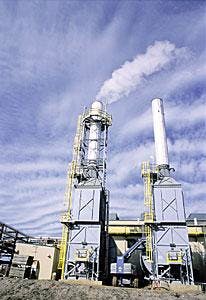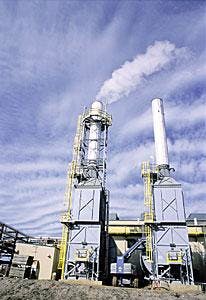Horizontal wells, multilateral wells, solvents, steam-assisted gravity drainage (SAGD), on site upgrading, in situ upgrading, and alternative fuels are some existing and emerging technologies that are improving the prospects for producing economically the world's vast heavy oil and bitumen resources
Presentations at The Resource 2 Reserves 2 Results Conference and Exhibition (R2R2R) in Calgary, Nov. 4-7, provided insights into the status of these technologies in various parts of the world and how emerging technology may help reduce drilling, development, and operating costs so that heavy-oil production remains viable even with volatile oil and gas price cycles.
The R2R2R conference combined the International Thermal Operations and Heavy Oil Symposium (ITOHOS) and International Conference on Horizontal Well Technology (ICHWT). The Petroleum Society of CIM (Canadian Institute of Mining, Metallurgy & Petroleum), Society of Petroleum Engineers (SPE), and Canadian Heavy Oil Association (CHOA) sponsored the event.
Canada
In Canada, the industry and various government organizations have evaluated SAGD processes for about the last 20 years.
In the late 1980s and early 1990s, an underground test facility (UTF) in Alberta's Athabasca tar sands first proved out in the field the technique of placing a steam-injection horizontal lateral a few meters above a producing horizontal lateral. Unlike the SAGD of today, these laterals were drilled horizontally from mined shafts.
Devon Canada Corp. now owns the UTF facility or Dover project and is conducting new tests from surface-drilled laterals while continuing to produce from some of the old UTF laterals.
John Pierce of Devon said one of Devon's experiments used ethane to evaluate the potential of gas-push SAGD. But because of high ethane prices, it now is evaluating flue gas for this process.
Devon at the site also heads a $30 million (Can) project for evaluating VAPEX technology. This technology involves injecting a solvent, rather than steam in the top lateral. For the pilot, Devon has completed the well pair and established communication between the laterals. Pierce said injection of a propane or propane-methane solvent will start in second quarter 2003.
Although SAGD is a proven technology for producing bitumen from Athabasca tars, the technology has not been completely successful in lighter heavy oils or other formations.
For instance, George Scott of Imperial Oil Resources Ltd. presented numbers that indicated that SAGD in the Clearwater formation in the Cold Lake area of Alberta was less economic than cyclic steam stimulation (CSS). He based the evaluation on energy consumed to produce a barrel of heavy oil.
Also, Bryan Gould of Shell Canada Ltd. said SAGD has not proven very successful in Shell's Peace Creek project. Shell has had a long history of pilot projects in the area, starting with pressure cyclic steaming of vertical wells between 1979-85.
Gould said Shell in 1992 was the first company to drill a SAGD well pair from surface, but production from this pair was disappointing. Other pairs drilled from 1993-97 preformed better, he said.
Since 1996, Shell in Peace Creek has evaluated cyclic steam injection in wells drilled with various multilateral patterns. Gould said these wells have much better steam-oil ratios than the SAGD well, and Shell plans to use this type of development to establish commercial oil production from the area of about 15,000 b/d.
Currently, Alberta and Saskatchewan have about 30 SAGD projects, 4 of which are large-scale commercial projects under development.
One project, the Nexen Inc. and OPTI Canada Inc. Long Lake project in Alberta, combines SAGD with on site upgrading.
The advantage of on site upgrading as discussed by Jim Arnold of OPTI Canada is that it removes the uncertainty of natural gas prices from crude oil recovery. The upgrading scheme includes the OPTI Canada patented OrCrude process. It produces an asphaltene by-product that will be fed to an asphaltene gasification system that produces hydrogen for the hydrocracker and a syngas that fuels the SAGD steam generators.
The advantage of syngas is that it eliminates natural gas prices and availability from project economics. He said the project is currently under regulatory review, and construction should start in 2003 with production starting in 2006. The first phase is designed to produce and upgrade 70,000 bbl of 8° gravity bitumen to a 60,000-b/d stream of 20° gravity product.
Outside Canada
Outside of Canada are such developments as the proposed Mukhaizna field, Oman. Ahmed Al-Azkawi, Petroleum Development Oman LLC (PDO) said Phase I for recovering the 14-16° heavy viscous oil will start in 2006 at about 16,000 cu m/day. Full field development calls for reaching 160,000 cu m/day of production by 2013. He said the project will require about 1,200 wells.
Not all heavy oil projects include steam. In Venezuela's Orinoco tar sands, the fourth integrated large-scale extra-heavy crude production project production continues to add horizontal and multilateral wells to achieve the target production requirements of its upgrader under construction on the Caribbean coast near Jose.
The project operated by Petrolera Ameriven (a joint venture of ConocoPhillips, Petroleos de Venezuela or PDVSA, and Chevron Texaco Inc.), during its 30-year plateau period will produce 190,000 b/d of 8° gravity crude oil that will be upgraded to 26° gravity export stream. Larry Gibson of Ameriven said the project has involved drilling horizontal laterals of up to 8,600-ft in record times of up to 4,657-ft in 12 hr.
Ameriven expects to recover about 2.2 billion bbl over the 30-year life of the $4-billion project. Gibson said the completion of the upgrader is on schedule and will start up in 2003. Initial production and export of non-upgraded crude started in 2001.
In another cold heavy-oil production success, the Jilin Oilfied Co. in the TaoBao oil field in Jilin Province China found that increased sand production led to increased oil production, as discussed in presentation by M. B. Dusseault, University of Waterloo, et al. The cold heavy-oil with sand (CHOPS) method first was proved out in Canada.
Electric heating is another technique still around. Ravindoe Sierra of Uentech International Corp. said Petrobras in the Canto do Amoro field in Brazil has started a four-well pilot to determine the effectiveness of a waterflood in conjunction with resistive heating that places an electrode downhole.
Sierra also said ConocoPhillips was evaluating this technology for Alaskan applications.
Tomas Mata of PDVSA said that company is continuing to pressure integrated field laboratories to validate several emerging technologies such as SAGD, CHOPS, electric heating, solvent injection, and in situ upgrading. He indicated early results of in situ upgrading look promising.

